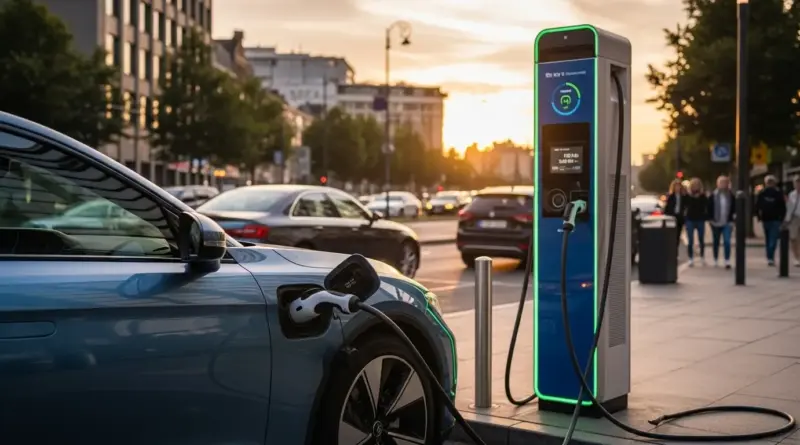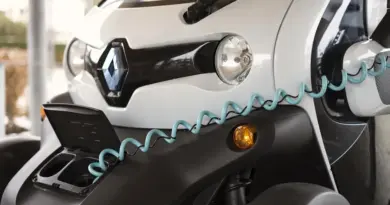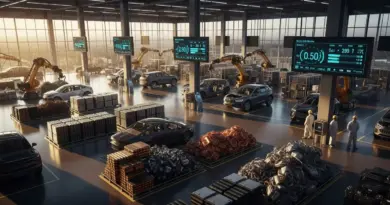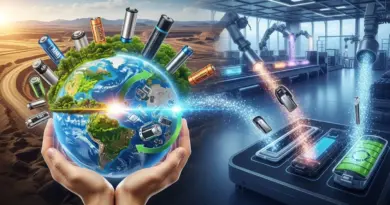The Great Debate on EV Battery Recycling: Debunking the Top 5 Myths
Last Updated on September 26, 2025 by Team Eletric Car
As the world accelerates toward electrification, the EV battery recycling debate has ignited fierce discussions, with critics raising alarms about environmental hazards and resource waste, while advocates highlight innovative solutions that turn spent batteries into valuable assets. Contrary to widespread misconceptions, EV battery recycling is not only feasible but increasingly efficient, recovering up to 95% of critical materials like lithium, cobalt, and nickel to fuel the next generation of vehicles and reduce mining demands.
See also:
Battery Recycling: What Happens to EV Batteries After 10 Years?
The Technology Behind Recycling Electric Car Batteries
This myth-busting exploration reveals that robust recycling processes, coupled with second-life applications, are already mitigating the challenges of battery end-of-life, ensuring electric vehicles (EVs) remain a cornerstone of sustainable transportation without the doomsday scenarios often portrayed.
Why the EV Battery Recycling Debate Matters in 2025
The surge in EV adoption—projected to exceed 37 million vehicles on U.S. roads by 2032 under policies like the Inflation Reduction Act—has thrust EV battery recycling into the spotlight. With lithium-ion batteries containing scarce minerals essential for energy storage, the question isn’t just about disposal but about building a circular economy that minimizes environmental impact and secures supply chains. Debates rage over whether recycling can scale to match the influx of end-of-life batteries, but evidence from facilities like Redwood Materials and international efforts shows progress is underway.
At its core, EV battery recycling addresses two imperatives: preventing pollution from toxic leaks into soil and groundwater, and conserving resources amid rising demand for cobalt and nickel. As of 2025, global recycling capacity is ramping up, with the U.S. alone poised to handle over 1.3 million batteries annually by 2030. Yet, myths persist, fueled by early-stage challenges like non-standardized packs and economic hurdles. Dispelling these is key to fostering public trust and accelerating the transition to cleaner mobility.
Myth 1: EV Batteries End Up in Landfills, Polluting the Environment
One of the most persistent fears is that EV batteries will overwhelm landfills, leaching hazardous chemicals and undermining the green credentials of electric vehicles. This image of massive battery graveyards ignores the reality of established reuse and recovery pathways.
In truth, EV batteries rarely see a landfill. When they reach the end of their vehicle life—typically after 8-10 years or 100,000-200,000 miles—they retain 70-80% capacity, making them ideal for second-life uses like grid storage or powering data centers. Only truly depleted packs go to recycling, where processes like hydrometallurgy extract 95% of materials, far surpassing aluminum can rates. Companies like Redwood Materials in Nevada are scaling operations to process thousands of tons annually, turning waste into raw inputs for new batteries.
Regulations reinforce this: The EU mandates 95% recyclability by 2030, while U.S. incentives under the Inflation Reduction Act prioritize recycled content. Far from pollution, EV battery recycling prevents it, conserving resources and cutting emissions by up to 50% compared to virgin mining.
Myth 2: Recycling EV Batteries Is Too Expensive and Economically Unviable
Skeptics argue that the high costs of dismantling complex EV batteries—with their welds, casings, and varying chemistries—make recycling a money pit, dooming it to failure without endless subsidies.
This overlooks the booming economics driven by material scarcity. Critical minerals like cobalt (prices up 20% in 2025) and nickel make recycling profitable; a single ton of battery scrap can yield $10,000 in recoverable metals. Facilities like Li-Cycle in New York report 90% recovery rates at costs competitive with mining, thanks to innovations like direct recycling that preserve cathode structures.
Government support, including $15 million from the U.S. Department of Energy for the ReCell Center, is bridging early gaps, but market forces are taking over. By 2040, recycling could supply over half of lithium and nickel needs, slashing costs by 30-40%. What starts as an investment yields dividends in supply security and reduced geopolitical risks from mineral-dependent regions.
Myth 3: Only 5% of EV Batteries Are Actually Recycled—It’s a Myth of Sustainability
A viral statistic claims a mere 5% recycling rate for lithium-ion batteries, painting EV battery recycling as a greenwashing facade that exacerbates waste.
This figure is a debunked relic from outdated consumer battery data, not EVs. Experts like Hans Eric Melin estimate global rates closer to 59% for end-of-life packs, with EV-specific recycling hitting 95% material recovery in advanced processes. The low number stems from conflating all lithium-ion sources—phones, tools—with automotive ones, where economics ensure higher handling.
In 2025, U.S. capacity stands at 105,000 tons annually, enough for 220,000 batteries, scaling to meet projections. Programs like Tesla’s in-house recycling loop 92% of materials back into production. The truth? EV battery recycling is maturing rapidly, outpacing the myth and proving sustainability is no illusion.
Debunking the 5% Myth: Recycling Rates at a Glance
| Battery Type/Source | Reported Recycling Rate | Reality for EVs |
|---|---|---|
| Consumer Electronics | ~5% (outdated global avg.) | Not applicable; EVs prioritize recovery |
| End-of-Life EV Packs | 59% (2023 estimate) | Up to 95% material recovery |
| U.S. Automotive Scrap | 90%+ in specialized plants | Scaling to 100% by 2030 via regulations |
This table clarifies the disconnect, showing EV-focused efforts far exceed the misleading aggregate.
Myth 4: EV Battery Recycling Is Technologically Impossible Due to Complexity
The intricate design of EV batteries—non-standardized packs from Tesla, BMW, or Nissan—leads to claims that disassembly is too hazardous and inefficient, rendering recycling a pipe dream.
Advancements shatter this notion. Robotic dismantling and AI-driven sorting, as used by Northvolt in Sweden, handle variations safely, avoiding short-circuits that could release fumes. Hydrometallurgical methods dissolve packs in acids to extract metals without shredding, achieving 99% purity for lithium and cobalt.
Challenges like safety persist, but solutions abound: Argonne National Lab’s ReLib project tests scalable tech, while China’s 2018 rules mandate component reuse. By 2025, facilities process 3,600 packs yearly at Volkswagen’s Salzgitter plant alone. Far from impossible, EV battery recycling is evolving into an engineering triumph.
Myth 5: EV Batteries Last Only a Few Years, Creating a Recycling Crisis Soon
Alarmists predict a flood of dead EV batteries within years, overwhelming nascent recycling infrastructure and sparking an environmental catastrophe.
Batteries defy this timeline. Warranties cover 8-10 years or 100,000 miles with 70% capacity retention, but real-world data shows 15-20 years of service, thanks to thermal management and over-the-air updates. Tesla reports packs lasting 300,000+ miles, with degradation under 10% annually.
Even “end-of-life” batteries get repurposed: Nissan reuses LEAF packs for solar storage, extending utility by 5-10 years. With EV fleets young—most pre-2023 models still roadworthy—the recycling wave peaks in 2035, giving time for capacity buildup. No crisis; just smart lifecycle management.
The Road Ahead: Innovations Shaping EV Battery Recycling
As the debate evolves, 2025 innovations promise a brighter horizon. Direct recycling preserves cathode integrity, cutting energy use by 80%, while startups like Ascend Elements use bio-leaching for eco-friendly extraction. Policies like the EU Battery Regulation enforce 16% recycled content by 2030, driving investment.
Challenges remain—standardization and collection logistics—but the trajectory is clear: EV battery recycling will not only debunk myths but redefine sustainability, powering a cleaner future.
Pros and Cons of Current EV Battery Recycling Practices
Pros
- Resource Conservation: Recovers 95% of metals, reducing mining by up to 50% and emissions.
- Economic Boost: Generates $10,000+ per ton in value, creating jobs in emerging facilities.
- Environmental Safeguard: Prevents toxic leaks, with second-life uses extending pack utility.
- Scalability: U.S. capacity set to handle 1.3M batteries/year by 2030.
- Innovation Driver: Spurs tech like AI sorting, lowering costs over time.
Cons
- Infrastructure Lag: Early-stage facilities handle scrap more than end-of-life packs.
- Cost Barriers: Initial disassembly remains pricey without subsidies.
- Safety Risks: Handling requires expertise to avoid fires or fumes.
- Global Disparities: Higher rates in EU/China vs. developing regions.
- Material Limits: Demand outpaces supply short-term, necessitating hybrid mining.
FAQs
Is EV battery recycling truly environmentally friendly?
Yes, EV battery recycling recovers 95% of materials, slashing mining emissions by 50% and preventing landfill pollution, though full lifecycle assessments confirm EVs’ net benefits.
How much of an EV battery can actually be recycled?
Up to 98% of components, including lithium and cobalt, with processes like hydrometallurgy achieving near-total recovery for critical minerals.
Will there be enough recycling capacity for future EV batteries?
Absolutely; U.S. projections show capacity for 1.3 million batteries annually by 2030, matching end-of-life influx from 37 million EVs.
Do EV batteries degrade too quickly to make recycling viable?
No, they last 15-20 years with 70%+ capacity, enabling second-life uses before recycling, debunking short-lifespan fears.
What’s the biggest challenge in EV battery recycling today?
Standardization of packs across manufacturers, but robotic and AI solutions are addressing this for safer, efficient dismantling.
Can recycled EV batteries match the quality of new ones?
Yes, advanced methods like direct recycling produce materials of equal purity, closing the loop for high-performance batteries.




